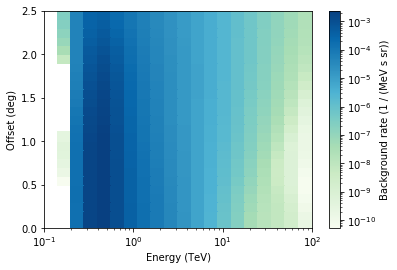This is a fixed-text formatted version of a Jupyter notebook
You can contribute with your own notebooks in this GitHub repository.
Source files: hess.ipynb | hess.py
H.E.S.S. data with Gammapy¶
H.E.S.S. is an array of gamma-ray telescopes located in Namibia. Gammapy is regularly used and fully supports H.E.S.S. high-level data analysis, after export to the current open data level 3 format.
The H.E.S.S. data is private, and H.E.S.S. analysis is mostly documented and discussed at https://hess-confluence.desy.de/ and in H.E.S.S.-internal communication channels. However, in 2018, a small sub-set of archival H.E.S.S. data was publicly released, called the H.E.S.S. DL3 DR1, the data level 3, data release number 1. This dataset is 50 MB in size and is used in many Gammapy analysis tutorials, and can be downloaded via
gammapy download (TODO: add link to description).
This notebook is a quick introduction to H.E.S.S. data and instrument responses and contains some specifics that are important for H.E.S.S. users:
IRF formats and shapes
How to handle safe energy and max offset
EVENTS and GTI formats (e.g. how HESS 1, 2, configs, … are handled)
Link to HESS Confluence where data and help is available (Slack channel)?
Then at the end, link to other analysis tutorials that are likely of interest for H.E.S.S. people, and add a few exercises. This can be short, a 5-10 min read. It’s just supposed to be the “landing page” for someone new in H.E.S.S. that has never used Gammapy.
DL3 DR1¶
This is how to access data and IRFs from the H.E.S.S. data level 3, data release 1.
[1]:
%matplotlib inline
import matplotlib.pyplot as plt
[2]:
from gammapy.data import DataStore
[3]:
data_store = DataStore.from_dir("$GAMMAPY_DATA/hess-dl3-dr1")
[4]:
data_store.info()
Data store:
HDU index table:
BASE_DIR: /Users/adonath/data/gammapy-data/hess-dl3-dr1
Rows: 630
OBS_ID: 20136 -- 47829
HDU_TYPE: ['aeff', 'bkg', 'edisp', 'events', 'gti', 'psf']
HDU_CLASS: ['aeff_2d', 'bkg_3d', 'edisp_2d', 'events', 'gti', 'psf_table']
Observation table:
Observatory name: 'N/A'
Number of observations: 105
[5]:
data_store.obs_table[:2][["OBS_ID", "DATE-OBS", "RA_PNT", "DEC_PNT", "OBJECT"]]
[5]:
| OBS_ID | DATE-OBS | RA_PNT | DEC_PNT | OBJECT |
|---|---|---|---|---|
| deg | deg | |||
| int64 | bytes10 | float32 | float32 | bytes18 |
| 20136 | 2004-03-26 | 228.6125 | -58.771667 | MSH15-52 |
| 20137 | 2004-03-26 | 228.6125 | -59.771667 | MSH15-52 |
[6]:
obs = data_store.obs(20136)
[7]:
obs.aeff.peek()
/Users/adonath/github/adonath/astropy/astropy/units/quantity.py:481: RuntimeWarning: invalid value encountered in true_divide
result = super().__array_ufunc__(function, method, *arrays, **kwargs)

[8]:
obs.edisp.peek()

[9]:
obs.psf.peek()

[10]:
obs.bkg.to_2d().plot()

Exercises¶
Find the
OBS_IDfor the runs of the Crab nebulaCompute the expected number of background events in the whole FOV for
OBS_ID=20136in the 1 TeV to 3 TeV energy band, from the background IRF.
Next steps¶
Now you know how to access and work with H.E.S.S. data. All other tutorials and documentation apply to H.E.S.S. and CTA or any other IACT that provides DL3 data and IRFs in the standard format.
